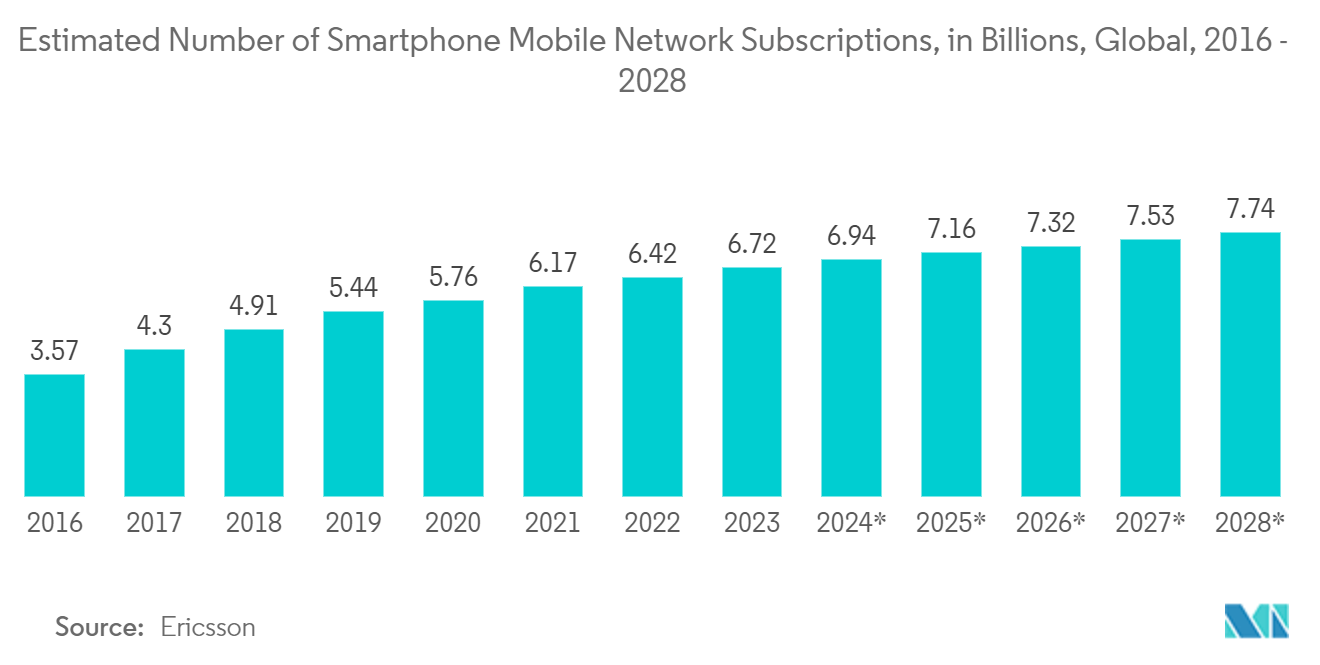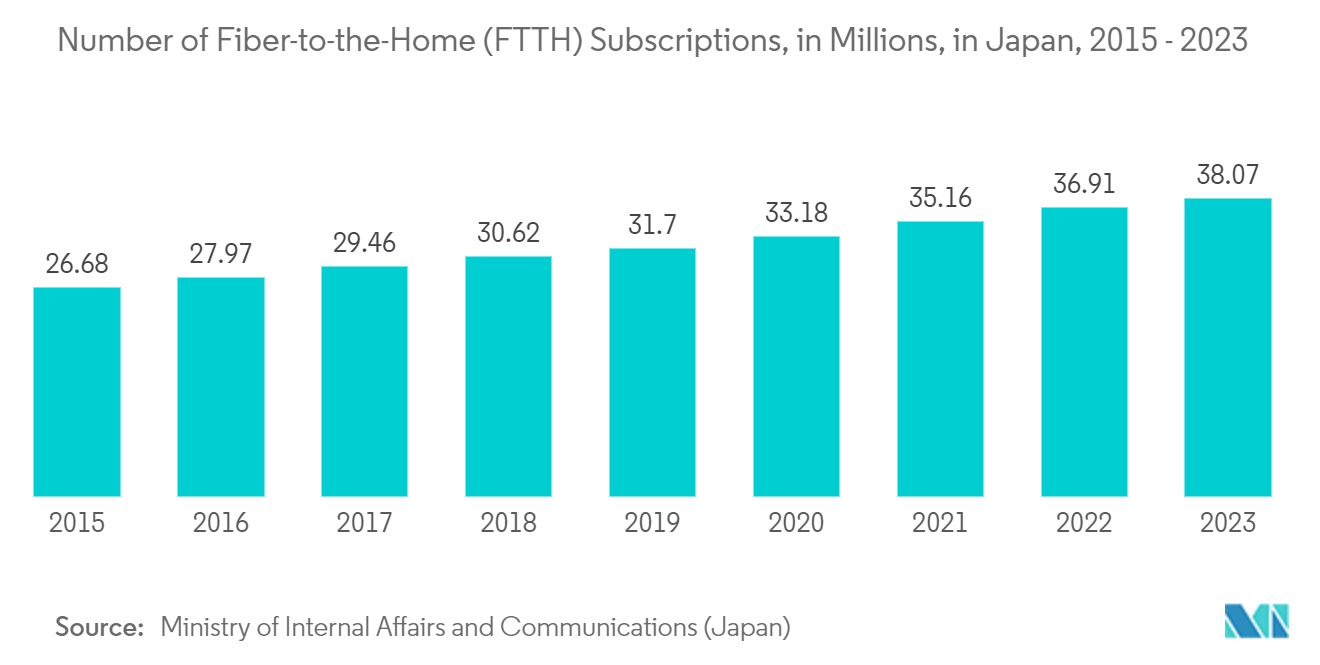Market Trends of Submarine Optical Fiber Cable Industry
Growing Smartphone Penetration and Increasing Demand for Internet Bandwidth to Drive the Market
- The smartphone industry has witnessed significant growth in recent years. The growing acceptance and prevalence of digital technologies, the advent of 5G, and the mobile-first approach of businesses are among the major factors driving the adoption of smartphones. According to Ericsson, the global number of smartphone subscribers is expected to reach 7.743 billion in 2028 from 6.421 billion in 2022.
- Furthermore, according to Ericsson, Northeast Asia was the leading region in terms of the number of smartphone subscribers (1.990 billion in 2022), followed by China (1.570 billion) and Southeast Asia and Oceania (910 million). All these factors positively contribute to the growth of the market studied, as a higher smartphone subscription positively impacts internet consumption and the amount of data being generated, which, in turn, drives the demand for data centers and other digital infrastructures wherein high bandwidth connectivity is a crucial requirement.
- According to the Ericsson Mobility report released in November 2023, a continued strong surge in global average data consumption per smartphone is expected to increase from 21GB/month in 2023 to 56GB/month by 2029. Such developments have positively influenced the increased demand for internet bandwidth and, in turn, driven the demand for submarine optical fiber cable.
- Increased bandwidth, ultra-low latency, and faster connectivity are expanding civilizations, revolutionizing industries, and radically improving day-to-day experiences. Bandwidth demands typically grow significantly every year. Hence, there is a constant trend toward higher bandwidth services and driving the growth of the submarine optical fiber cable market.
- For instance, in January 2024, Indian Prime Minister Narendra Modi, in Kavaratti, Lakshadweep, inaugurated the Kochi-Lakshadweep islands submarine optical fiber connection (KLI-SOFC) project among various developmental projects worth more than INR 1,150 crore (USD 13.88 million) covering a wide range of sectors, including water resources, healthcare, technology, energy, and education.
- The KLI-SOFC project will boost internet speed, unlocking new possibilities and opportunities. The dedicated submarine OFC will ensure a paradigm shift in communication infrastructure in the Lakshadweep islands, enabling more and faster reliable internet services, educational initiatives, digital banking, telemedicine, e-governance, digital currency usage, digital literacy, etc.
- Such developments, coupled with growing smartphone penetration and a growing need for reliable, low-latency, and high-speed communication infrastructure worldwide, are expected to drive the growth of the market studied during the forecast period.

Trans-Pacific Region is Expected to Hold Significant Market Share
- Submarine cables carry over 97% of all internet traffic worldwide, and nearly everyone uses the Internet for daily tasks. Due to the Internet's ability to connect people worldwide, international traffic is growing daily. Asia-Pacific accounts for about half of all internet traffic worldwide, which in turn is increasing demand for submarine communication cables. The lack of submarine communication cable systems in the countries in this region is to blame for the need for faster internet services in the Transpacific region, which has prompted the World Bank and the Asia Development Bank to fund new cable systems.
- According to the Ministry of Internal Affairs and Communications (Japan), in 2023, the number of fiber-to-the-home (FTTH) subscriptions in Japan reached more than 38 million. In 1999, FTTH was introduced to the Japanese market, providing high bandwidth and high-speed internet access at a comparatively low price.
- As of October 2023, according to a joint US-Australian agreement, Alphabet (Google) operated underwater cables that provided internet connectivity to at least eight isolated Pacific Ocean countries. The project aims to expand Google's existing business activities in the region. Micronesia, Kiribati, the Marshall Islands, Papua New Guinea, the Solomon Islands, Timor-Leste, Tuvalu, and Vanuatu are all included in the project.
- In January 2023, Infinera announced that Infinera's ICE6 800G coherent optical solution had been deployed to modernize and increase capacity on the trans-Pacific Unity submarine cable system. By upgrading to Infinera's ICE6 solution, the Unity cable system will double capacity and deliver up to 7.4 Tbps per fiber pair. The Unity cable system was ready for service in April 2010, jointly built by a consortium comprising Bharti Airtel Limited, Global Transit Limited (a wholly-owned subsidiary of TIME), Google, KDDI Corp., Telstra, and Singtel.
- Moreover, according to Corporate IT, the Fondo de Infraestructura SA of Chile has selected H2 Cable LP, a subsidiary of BW Digital, as a strategic partner for developing the Humboldt Cable System, the first submarine cable connecting Latin America with Asia-Pacific and Oceania. With a projected extension of 14,810 km, the Humboldt Cable System will provide end-to-end connectivity.


